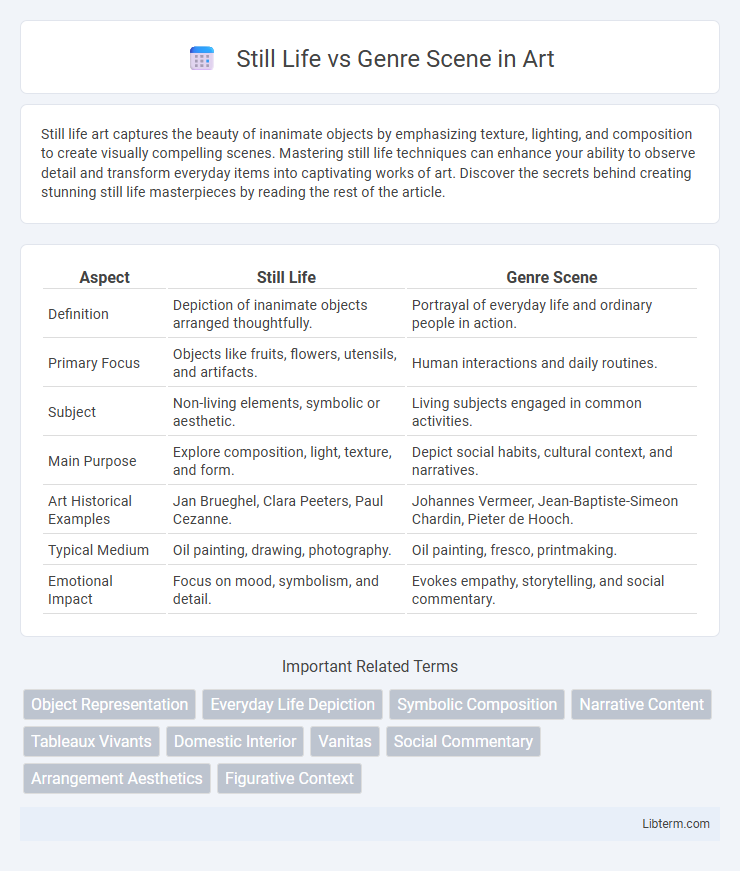Still life art captures the beauty of inanimate objects by emphasizing texture, lighting, and composition to create visually compelling scenes. Mastering still life techniques can enhance your ability to observe detail and transform everyday items into captivating works of art. Discover the secrets behind creating stunning still life masterpieces by reading the rest of the article.
Table of Comparison
| Aspect | Still Life | Genre Scene |
|---|---|---|
| Definition | Depiction of inanimate objects arranged thoughtfully. | Portrayal of everyday life and ordinary people in action. |
| Primary Focus | Objects like fruits, flowers, utensils, and artifacts. | Human interactions and daily routines. |
| Subject | Non-living elements, symbolic or aesthetic. | Living subjects engaged in common activities. |
| Main Purpose | Explore composition, light, texture, and form. | Depict social habits, cultural context, and narratives. |
| Art Historical Examples | Jan Brueghel, Clara Peeters, Paul Cezanne. | Johannes Vermeer, Jean-Baptiste-Simeon Chardin, Pieter de Hooch. |
| Typical Medium | Oil painting, drawing, photography. | Oil painting, fresco, printmaking. |
| Emotional Impact | Focus on mood, symbolism, and detail. | Evokes empathy, storytelling, and social commentary. |
Defining Still Life: Key Characteristics
Still life paintings emphasize inanimate objects such as food, flowers, and household items arranged with careful composition, highlighting texture, color, and light to evoke mood or symbolism. Unlike genre scenes that depict human activities and social interactions in everyday settings, still lifes focus on the aesthetic and symbolic qualities of objects themselves. Key characteristics include meticulous attention to detail, controlled lighting, and a deliberate selection of items to convey meaning or showcase artistic skill.
Understanding Genre Scene: An Overview
Genre scenes depict everyday life activities, capturing moments of ordinary people engaged in common tasks, offering insight into social customs and cultural contexts. These scenes often emphasize narrative elements and character interactions, contrasting with still life's focus on inanimate objects arranged for aesthetic contemplation. Understanding genre scenes involves recognizing their role in reflecting societal values, emotions, and everyday experiences through detailed and dynamic compositions.
Historical Origins of Still Life Art
Still life art originated in ancient Egypt and Greece, where symbolic representations of objects conveyed religious and cultural meanings. During the Renaissance, still life gained prominence as artists emphasized realism and detailed depictions of everyday items to showcase skill and explore themes of mortality and abundance. The genre further evolved in the 17th century Dutch Golden Age, where exquisite arrangements of food, flowers, and household items reflected wealth and human transience.
Evolution of Genre Scene Paintings
Genre scene paintings evolved significantly from the Renaissance to the Baroque period, reflecting everyday life and social interactions with increasing realism and emotional depth. Artists like Jan Steen and Pieter de Hooch introduced complex compositions and detailed domestic interiors, highlighting common people's activities rather than idealized subjects. This shift emphasized narrative storytelling and cultural context, distinguishing genre scenes from the static, symbolic nature of still life paintings.
Symbolism in Still Life Works
Still life artworks employ symbolism through carefully chosen objects that represent themes such as mortality, wealth, and the passage of time, often using motifs like skulls, hourglasses, or fruit to convey deeper meanings. Unlike genre scenes, which depict everyday human activities and social interactions, still life compositions emphasize the inherent symbolism embedded in inanimate items, inviting contemplation on life's transient nature. The deliberate arrangement of symbolic elements in still life works reveals cultural values and philosophical reflections distinct from the narrative focus of genre scenes.
Storytelling Elements in Genre Scenes
Genre scenes excel in storytelling through dynamic human interactions and everyday activities, conveying emotions, social contexts, and narratives within a single frame. Unlike still life paintings that focus on inanimate objects arranged for visual harmony and symbolism, genre scenes capture moments of life, revealing characters' roles, tensions, and cultural settings. This narrative depth engages viewers by prompting interpretations about the depicted story, making genre scenes a rich medium for visual storytelling in art history.
Artistic Techniques: Still Life vs Genre Scene
Still life paintings emphasize meticulous control over composition, lighting, and texture to highlight the symbolic meaning of inanimate objects, using techniques like chiaroscuro and precise brushwork to create a sense of realism and depth. Genre scenes employ dynamic perspectives and expressive figure drawing to capture everyday human interactions and social environments, often utilizing loose brushstrokes and vibrant color palettes to convey movement and emotion. The technical contrast lies in still life's focus on static detail and tonal harmony versus genre scene's emphasis on narrative motion and atmospheric effects.
Social and Cultural Contexts
Still Life paintings often reflect the social and cultural values of their time by depicting everyday objects that symbolize wealth, mortality, or domestic life, revealing insights into economic status and societal priorities. Genre Scenes portray ordinary people engaged in daily activities, illustrating social interactions and cultural practices, thus offering a narrative of communal life and social norms. Both art forms serve as visual documents that capture and convey the complexities of social hierarchy, cultural rituals, and historical contexts.
Influential Artists and Notable Examples
Still life art features influential artists like Caravaggio, whose dramatic chiaroscuro enhanced the realism of objects, and Paul Cezanne, renowned for his structured compositions of fruit and household items. Notable examples include Caravaggio's "Basket of Fruit" and Cezanne's "The Basket of Apples," both exemplifying meticulous detail and composition. Genre scenes depict everyday life, with artists such as Johannes Vermeer, famous for "The Milkmaid," and Pieter de Hooch, known for intimate domestic interiors rich in light and perspective.
Modern Interpretations and Contemporary Trends
Modern interpretations of still life emphasize dynamic compositions and interactive elements, challenging traditional static displays by incorporating multimedia and mixed media techniques. Contemporary genre scenes shift towards depicting diverse social narratives and everyday moments through immersive, often digital, storytelling approaches that reflect current cultural values. Both genres embrace innovative materials and conceptual frameworks, blurring historical boundaries while resonating with present-day audiences.
Still Life Infographic

 libterm.com
libterm.com